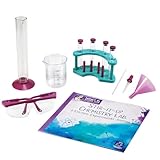Chemistry can be a daunting subject, but chemistry sets for kids make learning about basic chemistry concepts fun and inviting. Many children learn best when presented with hands-on experiences, and science kits lend themselves easily to this type of teaching and learning. While some kits, often designed for older kids, include all of the components for more advanced scientific learning and, there are plenty of chemistry kits for kids that focus on the fun aspects of science.
Whether you are encouraging the youngest scientists to learn basic concepts in a way that resembles play, or helping an older child to prepare for advanced concepts and lab situations, there is something to suit each need. When choosing chemistry sets for kids, consider your child’s age and experience level. A younger child may enjoy a basic kit with humorous experiments, while older children may benefit from more in-depth scientific exploration.
Fun and Educational Chemistry Sets For Kids
 | Thames & Kosmos CHEM C3000 (V 2.0) | Check price at |
 | The Magic School Bus – Chemistry Lab | Check price at |
 | SmartLab Toys Ultimate Secret Formula Lab | Check price at |
 | Be Amazing Toys Big Bag Of Science | Check price at |
 | Educational Insights Nancy B’s Science Club Stir-It-Up Chemistry Lab | Check price at |
 | Scientific Explorer Magic Science Kit for Wizards Only Lowest Price | Check price at |
1. Thames & Kosmos CHEM C3000 (V 2.0)
The Thames & Kosmos CHEM C3000 (V 2.0) is the premier choice in chemistry sets for kids. This is an advanced chemistry set, intended for children 12 and up, and is an excellent way to prepare your child for high school chemistry classes. But, any child with an interest in science and chemistry will enjoy the experiments, and younger children can perform many experiments with the help of an adult. The set includes 103 pieces like vials, test tubes, acids, bases, many tools, and even an alcohol burner. All of the pieces store easily in the secure plastic trays. Introduce more advanced concepts like chemical equations, atomic structures, and the periodic table with this comprehensive kit.
Recommended Ages: 12+
2. The Magic School Bus – Chemistry Lab

Recommended Ages: 5–12
3. SmartLab Toys Ultimate Secret Formula Lab

Recommended Ages: 8+
4. Be Amazing Toys Big Bag Of Science

Recommended Ages: 8–14
5. Educational Insights Nancy B’s Science Club Stir-It-Up Chemistry Lab
While some chemistry sets include more than 100 components, the Educational Insights Nancy B’s Science Club Stir-It-Up Chemistry Lab keeps learning simple. This simple kit includes necessary equipment like a beaker, test tubes, rack, graduated cylinder, lab glasses, dropper, funnel, and stirring rod. But, there aren’t a lot of liquids and powders. This unique kit uses common household items and the scientific method to complete experiments. Fun activities include extinguishing a flame with invisible gas, making bubbling “lava” in a bottle, and causing chemicals to change color. Explore basic chemistry concepts like atoms, molecules, and density. In addition, the kit includes a 22-page activity journal with experiment instructions, activities, and writing prompts.
Recommended Ages: 8–12
6. Scientific Explorer Magic Science Kit for Wizards Only

Recommended Ages: 6–10
7. Balance Living Chemistry Fun Lab Set
The Balance Living Chemistry Fun Lab Set has everything to perform more than 40 exciting chemistry experiments. This kit uses safe materials and equipment to introduce chemical reactions, acids and bases, measurements, and more; there are no potentially dangerous chemicals and no glass equipment to break. Safety goggles included. Children use the detailed, easy-to-understand, instruction manual to complete experiments like crystal strings, invisible ink, foaming monsters, rockets, and much more. This set is designed for children ages 10 and up, and younger children may require some assistance from a parent.
Recommended Ages: 5+
What do you think of these chemistry sets for kids? We love to hear from you! Let us know in the comments section.
Feature image courtesy of Flickr, Iwan Gabovitch.




